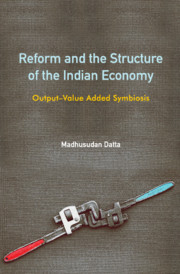Book contents
- Frontmatter
- Dedication
- Contents
- Tables
- Figures and Box
- Preface
- 1 Introduction: The Take-off
- 2 Growth and Structural Change since 1978–79: Issues in Measurement
- 3 Sectoral Shares in Indian GDP: How to Regard It?
- 4 Sectoral Growth: GVA–Output Dichotomy
- 5 Manufacturing Sector in the Indian Economy: Paradox of Growth and Stagnation
- 6 Growth and Sectoral GVA Adjustments
- 7 Demand for Intermediate Services
- 8 Linkages and Key Sectors in the Indian Economy
- 9 Conclusion: A Perspective of Indian Economic Growth
- References
- Index
6 - Growth and Sectoral GVA Adjustments
Published online by Cambridge University Press: 17 March 2020
- Frontmatter
- Dedication
- Contents
- Tables
- Figures and Box
- Preface
- 1 Introduction: The Take-off
- 2 Growth and Structural Change since 1978–79: Issues in Measurement
- 3 Sectoral Shares in Indian GDP: How to Regard It?
- 4 Sectoral Growth: GVA–Output Dichotomy
- 5 Manufacturing Sector in the Indian Economy: Paradox of Growth and Stagnation
- 6 Growth and Sectoral GVA Adjustments
- 7 Demand for Intermediate Services
- 8 Linkages and Key Sectors in the Indian Economy
- 9 Conclusion: A Perspective of Indian Economic Growth
- References
- Index
Summary
I WILL add one Thing although it be a little out of Place; … But my Caution is occasioned by a Lady of your Acquaintance, married to a very valuable Person, whom yet she is so unfortunate as to be always commanding for those Perfections, to which he can least pretend.
—Swift, ‘A Letter to a Young Lady, On Her Marriage, 1723’, in Rawson and Higgins (2010: 269)Introduction
The manufacturing sector has traditionally been the main theatre of technological progress. This sector constantly upgrades the existing products and creates new ones that are, unlike agricultural products, demanded more and more, apparently without a limit, as income rises. That is the amazing ability of the capitalist civilization to enlarge the sphere of its needs indefinitely. Yet, as per national product data of a typical modern economy, the manufacturing sector gradually gets eclipsed by service production. This has stirred the interest of many an observer. A simple hypothesis of differential productivity growth across sectors with competitive factor rewards, elaborated in the previous chapter, leads to the conclusion that the relatively technologically non-progressive activities, which are typically to be found more in the service sector than in manufacturing, will experience above average cost and price increases paving the way for increase in value added faster than output. The reverse narrative holds for the more progressive sectors, particularly for manufacturing. This idea has being churned ever since it was propounded though much has changed on the technological front with revolution in information technology that has kept the service sector on the boil in recent times (Triplett and Bosworth, 2003).
We have indicated in the last chapter that the Indian economy shows strong evidence of changes consistent with the above observations. It is of natural interest to ask, precisely how relevant the cost (and value added) adjustment have been in the context of stagnant relative GDP share of the manufacturing sector and rapidly rising share of services since the turn of the 1970s. The present discussion takes lead from the last chapter to obtain more specific answers to the question of GVA adjustments.
- Type
- Chapter
- Information
- Reform and the Structure of the Indian EconomyOutput-Value Added Symbiosis, pp. 101 - 122Publisher: Cambridge University PressPrint publication year: 2020



